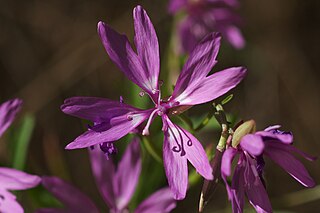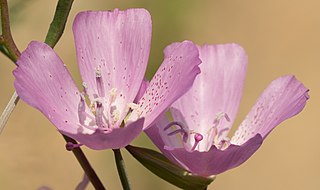
Fremontodendron, with the common names fremontia, flannelbush, and flannel bush, is a genus of three known species of shrubs native to the Southwestern United States and northwest Mexico.

Fremontodendron californicum, with the common names California flannelbush, California fremontia, and flannel bush, is a flowering shrub native to diverse habitats in southwestern North America.

Clarkia gracilis is a species of wildflower known by the common name slender clarkia. This plant is native to the US states of California, Oregon, and Washington, where it is found in coastal, foothill, valley, and low-elevation mountain habitats. The plant is variable across subspecies but is generally an erect slender stem with a few sparse, narrow leaves several centimeters long. It bears an inflorescence of drooping buds which open into bowl-shaped flowers with pinkish lavender petals 1 to 4 centimeters long and bearing a red or white splotch which can appear in the center or at the base of the petal, depending on the subspecies.

Clarkia purpurea is a species of wildflower known by the common names winecup clarkia, winecup fairyfan, and purple clarkia.

Clarkia cylindrica is a species of flowering plant in the evening primrose family known by the common name speckled fairyfan, or speckled clarkia.

Clarkia arcuata is a species of flowering plant in the evening primrose family known by the common name glandular clarkia. It is endemic to California, where it grows in the chaparral and woodlands of the foothills of the Sierra Nevada and southern Cascade Range. It is an annual herb producing a slender, erect stem often exceeding half a meter in height. The leaves are narrow, usually linear or lance-shaped, and up to 6 centimeters long. The inflorescence bears a few flowers, which dangle when they are buds and grow erect as they open. The sepals stay fused as the petals open and emerge from one side. They are coated in glandular hairs. The petals are up to 3 centimeters long, pink-lavender in color, sometimes with a reddish blotch at the base. They form a bowl-shaped corolla. There are 8 stamens and a protruding, four-chambered ovary. The fruit is an elongated capsule which may reach 3.5 centimeters long.
Clarkia australis is a species of flowering plant in the evening primrose family known by the common name Small's southern clarkia. It is endemic to California, where it grows in the forests of the central Sierra Nevada. It is an uncommon species threatened by such forest activities as logging. This annual herb produces a slender, erect stem approaching a meter in height. The leaves are widely linear in shape and borne on short petioles. The top of the stem is occupied by the tall inflorescence, which bears hanging buds that open from the lowest upward so that there are several closed buds above open flowers. The sepals do not remain fused as the flower opens. The petals are diamond-shaped and sometimes lobed and curling at the tip. They are mottled or spotted lavender, purple, and reddish in color, and each is up to 1.5 centimeters long. There are 8 long stamens tipped with large anthers bearing blue-gray pollen. The stigma protrudes past the anthers.

Clarkia biloba is a species of flowering plant in the evening primrose family known by the common name twolobe clarkia and two lobed clarkia.
Clarkia borealis is a rare species of flowering plant in the evening primrose family known by the common name northern clarkia. It is endemic to California, where it is known from the forests of the southern Klamath Range and the southernmost Cascade Range foothills. It is an annual herb growing an erect, slender stem. The leaves are oval in shape and borne on short petioles. The top of the stem is occupied by the inflorescence, in which the lowest flowers open first and hanging, pointed flower buds occur at nodes at the top. The sepals separate as the flower blooms, revealing purplish pink petals. Each petal is between 1 and two centimeters long, elongated triangular to semicircular in shape, and sometimes flecked with dark purple. There are 8 stamens with anthers bearing blue-gray pollen, and a protruding stigma.

Clarkia dudleyana is a species of flowering plant in the evening primrose family known by the common name Dudley's clarkia. It is endemic to California, where it can be found in the mountains of the Transverse Ranges and the southern Sierra Nevada foothills. It grows in woodland, forest, and chaparral habitats under 1500 meters in elevation. This annual herb produces an erect stem sometimes exceeding half a meter in height. The leaves are lance-shaped, up to 7 centimeters long, and borne on short petioles. The top of the stem is occupied by the inflorescence, which has opening flowers below closed, hanging buds. As the flower blooms the pink to reddish-purple sepals remain fused, opening along one side only. The petals are up to 3 centimeters long, fan-shaped, pinkish lavender in color and sometimes flecked with red. There are 8 stamens, some of which have large lavender anthers and some that have smaller, paler anthers. The stigma protrudes farther than the stamens.

Clarkia exilis is a small herbaceous annual plant of western North America. It is an uncommon species in the evening primrose family known by the common names Kern River clarkia and slender clarkia.

Clarkia franciscana is a rare species of flowering plant in the evening primrose family known by the common name Presidio clarkia. It is endemic to the San Francisco Bay Area of California, where it is known only from two populations at the Presidio of San Francisco and three occurrences in Oakland. The plant is known only from serpentine soils.

Clarkia mildrediae is an uncommon species of flowering plant in the evening primrose family known by the common name Mildred's clarkia. It is endemic to California, where it is known from the forests of the southernmost Cascade Range and northern Sierra Nevada. It is an erect annual herb often exceeding half a meter in height. The oval leaves grow up to 6 centimeters long and are borne on petioles of up to 4 centimeters. The inflorescence bears opening flowers and hanging, pointed flower buds. As the bud opens the sepals all separate instead of remaining fused as those of many other Clarkia species do. The triangular to semicircular petals are about 2 centimeters long and lavender to bright reddish-purple, sometimes with dark speckling. There are 8 stamens with anthers all alike, and a protruding stigma.

Clarkia modesta is a species of flowering plant in the evening primrose family known by the common name Waltham Creek clarkia. It is endemic to California, where it is known from the woodlands of several of the central mountain ranges, including the North and Central Coast Ranges and the Sierra Nevada foothills. It is an erect annual herb often exceeding half a meter in height. The oval, linear, or lance-shaped leaves are 2 to 4 centimeters long. The inflorescence bears opening flowers and closed, hanging flower buds. The sepals remain fused as the petals bloom from one side. The petals are about a centimeter long and vary in shape from diamond to widely lance-shaped. They are pale to deep pink and generally dark-flecked or spotted.

Clarkia mosquinii is a rare species of flowering plant in the evening primrose family known by the common name Mosquin's clarkia. It is endemic to California, where it is known only from the northern Sierra Nevada foothills at the border between Butte and Plumas Counties. It was thought to be extinct until it was rediscovered in 1991. It is an erect annual herb often exceeding half a meter in height. The oval or lance-shaped leaves are 2 to 5 centimeters long. The inflorescence bears opening flowers below a series of clusters of closed, hanging flower buds. The sepals all separate as the flower blooms. The diamond-shaped petals are one to two centimeters long light to medium purple in color, and sometimes speckled with reddish purple.
Clarkia rostrata is a species of flowering plant in the evening primrose family known by the common name beaked clarkia.

Clarkia springvillensis is a rare species of flowering plant in the evening primrose family known by the common name Springville clarkia. It is endemic to central Tulare County, California, where it is known from fewer than 20 occurrences around Springville. It is a federally listed threatened species.
Clarkia tembloriensis is a rare species of flowering plant in the evening primrose family, known by the common name Temblor Range clarkia and belonging to the Onagraceae family.

Clarkia williamsonii is a species of flowering plant endemic to California, where it is known from the forests and woodlands of the northern and central Sierra Nevada foothills.

Clarkia xantiana is a species of flowering plant in the evening primrose family known by the common name gunsight clarkia. It is endemic to California, where it is known from the southern Sierra Nevada and its foothills and the adjacent Transverse Ranges. This is an erect annual herb with linear to lance-shaped leaves each up to 6 centimeters long. The inflorescence produces opening flowers and closed buds. The sepals stay fused as the petals bloom from one side. Each petal is up to 2 centimeters long and generally light to medium purple in color, sometimes with a dark, ringed spot on the petals of the upper whorl. The petal has a narrow claw and a wider blade which has two lobes at the tip with a small tooth between.
















